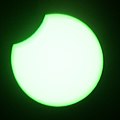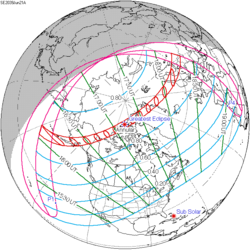Top Qs
Timeline
Chat
Perspective
Solar eclipse of June 10, 2021
Annular solar eclipse From Wikipedia, the free encyclopedia
Remove ads
An annular solar eclipse occurred at the Moon’s ascending node of orbit on Thursday, June 10, 2021,[1][2][3][4] with a magnitude of 0.9435. A solar eclipse occurs when the Moon passes between Earth and the Sun, thereby totally or partly obscuring the Sun for a viewer on Earth. An annular solar eclipse occurs when the Moon's apparent diameter is smaller than the Sun's, blocking most of the Sun's light and causing the Sun to look like an annulus (ring). An annular eclipse appears as a partial eclipse over a region of the Earth thousands of kilometres wide. Occurring about 2.3 days after apogee (on June 8, 2021, at 3:30 UTC), the Moon's apparent diameter was smaller.[5]
The annular eclipse was visible from parts of northeastern Canada (particularly Ontario and Nunavut), Greenland, the Arctic Ocean (passing over the North Pole),[6] and the Russian Far East. A partial eclipse was visible for parts of northern North America, Europe, and North Asia.[7]
Remove ads
Path

The annular eclipse started at 09:55 UTC for 3 minutes 37 seconds along the northern shore of Lake Superior in Ontario, Canada. The path of the antumbral shadow then headed across Hudson Bay through northwestern Quebec and the Hudson Strait to Baffin Island in Nunavut, where the town of Iqaluit saw 3 minutes and 5 seconds of annularity. After this, it then travelled across Baffin Bay and along the northwestern coast of Greenland, where the point of greatest eclipse occurred at 10:41 UTC in Nares Strait for 3 minutes 51 seconds. The shadow then crossed Ellesmere Island and the Arctic Ocean, passing over the North Pole (which was located away from the central line of the eclipse but saw 2 minutes and 36 seconds of annularity), before heading south towards northeastern Siberia, where the city of Srednekolymsk saw 3 minutes and 35 seconds of annularity at 11:27 UTC. Shortly afterwards, the central line of the annular eclipse ended at 11:29 UTC.[8][9]
Remove ads
Eclipse timing
Places experiencing annular eclipse
Places experiencing partial eclipse
Remove ads
Gallery
- Eclipse over the Statue of Liberty in New York City
- Montpelier, Vermont, 9:33 UTC
- Killingly, Connecticut, 9:35 UTC
- Lewes, Delaware, 9:42 UTC
- Arlington, Virginia, 9:56 UTC
- Logroño, Spain, 10:10 UTC
- Projection from Prague, Czechia, 10:24 UTC
- Haut-Doubs, France, 10:26 UTC
- Projection through leaves in Woerden, Netherlands, 10:30 UTC
- Brastad, Sweden, 10:32 UTC
- Lino Lakes, Minnesota, 10:33 UTC
- Berlin, Germany, 10:38 UTC
- Saint Petersburg, Russia, 11:09 UTC
- Partial from Tõrva, Estonia
- Petrozavodsk, Russia, 11:27 UTC, Coronado telescope
- Timelapse-video from Akademgorodok, Novosibirsk, Russia
- Timelapse-video from Kharbalakh, Yakutia, Russia
Eclipse details
Summarize
Perspective
Shown below are two tables displaying details about this particular solar eclipse. The first table outlines times at which the Moon's penumbra or umbra attains the specific parameter, and the second table describes various other parameters pertaining to this eclipse.[10]
Remove ads
Eclipse season
This eclipse is part of an eclipse season, a period, roughly every six months, when eclipses occur. Only two (or occasionally three) eclipse seasons occur each year, and each season lasts about 35 days and repeats just short of six months (173 days) later; thus two full eclipse seasons always occur each year. Either two or three eclipses happen each eclipse season. In the sequence below, each eclipse is separated by a fortnight.
Remove ads
Related eclipses
Eclipses in 2021
- A total lunar eclipse on May 26.
- An annular solar eclipse on June 10.
- A partial lunar eclipse on November 19.
- A total solar eclipse on December 4.
Metonic
- Preceded by: Solar eclipse of August 21, 2017
- Followed by: Solar eclipse of March 29, 2025
Tzolkinex
- Preceded by: Solar eclipse of April 29, 2014
- Followed by: Solar eclipse of July 22, 2028
Half-Saros
- Preceded by: Lunar eclipse of June 4, 2012
- Followed by: Lunar eclipse of June 15, 2030
Tritos
- Preceded by: Solar eclipse of July 11, 2010
- Followed by: Solar eclipse of May 9, 2032
Solar Saros 147
- Preceded by: Solar eclipse of May 31, 2003
- Followed by: Solar eclipse of June 21, 2039
Inex
- Preceded by: Solar eclipse of June 30, 1992
- Followed by: Solar eclipse of May 20, 2050
Triad
- Preceded by: Solar eclipse of August 10, 1934
- Followed by: Solar eclipse of April 11, 2108
Solar eclipses of 2018–2021
This eclipse is a member of a semester series. An eclipse in a semester series of solar eclipses repeats approximately every 177 days and 4 hours (a semester) at alternating nodes of the Moon's orbit.[11]
The partial solar eclipses on February 15, 2018 and August 11, 2018 occur in the previous lunar year eclipse set.
Saros 147
This eclipse is a part of Saros series 147, repeating every 18 years, 11 days, and containing 80 events. The series started with a partial solar eclipse on October 12, 1624. It contains annular eclipses from May 31, 2003 through July 31, 2706. There are no hybrid or total eclipses in this set. The series ends at member 80 as a partial eclipse on February 24, 3049. Its eclipses are tabulated in three columns; every third eclipse in the same column is one exeligmos apart, so they all cast shadows over approximately the same parts of the Earth.
The longest duration of annularity will be produced by member 38 at 9 minutes, 41 seconds on November 21, 2291. All eclipses in this series occur at the Moon’s ascending node of orbit.[12]
Metonic series
The metonic series repeats eclipses every 19 years (6939.69 days), lasting about 5 cycles. Eclipses occur in nearly the same calendar date. In addition, the octon subseries repeats 1/5 of that or every 3.8 years (1387.94 days). All eclipses in this table occur at the Moon's ascending node.
Tritos series
This eclipse is a part of a tritos cycle, repeating at alternating nodes every 135 synodic months (≈ 3986.63 days, or 11 years minus 1 month). Their appearance and longitude are irregular due to a lack of synchronization with the anomalistic month (period of perigee), but groupings of 3 tritos cycles (≈ 33 years minus 3 months) come close (≈ 434.044 anomalistic months), so eclipses are similar in these groupings.
Inex series
This eclipse is a part of the long period inex cycle, repeating at alternating nodes, every 358 synodic months (≈ 10,571.95 days, or 29 years minus 20 days). Their appearance and longitude are irregular due to a lack of synchronization with the anomalistic month (period of perigee). However, groupings of 3 inex cycles (≈ 87 years minus 2 months) comes close (≈ 1,151.02 anomalistic months), so eclipses are similar in these groupings.
Remove ads
Notes
- The time listed here for this location occurs on June 11, 2021, local time.
References
External links
Wikiwand - on
Seamless Wikipedia browsing. On steroids.
Remove ads



























































































































